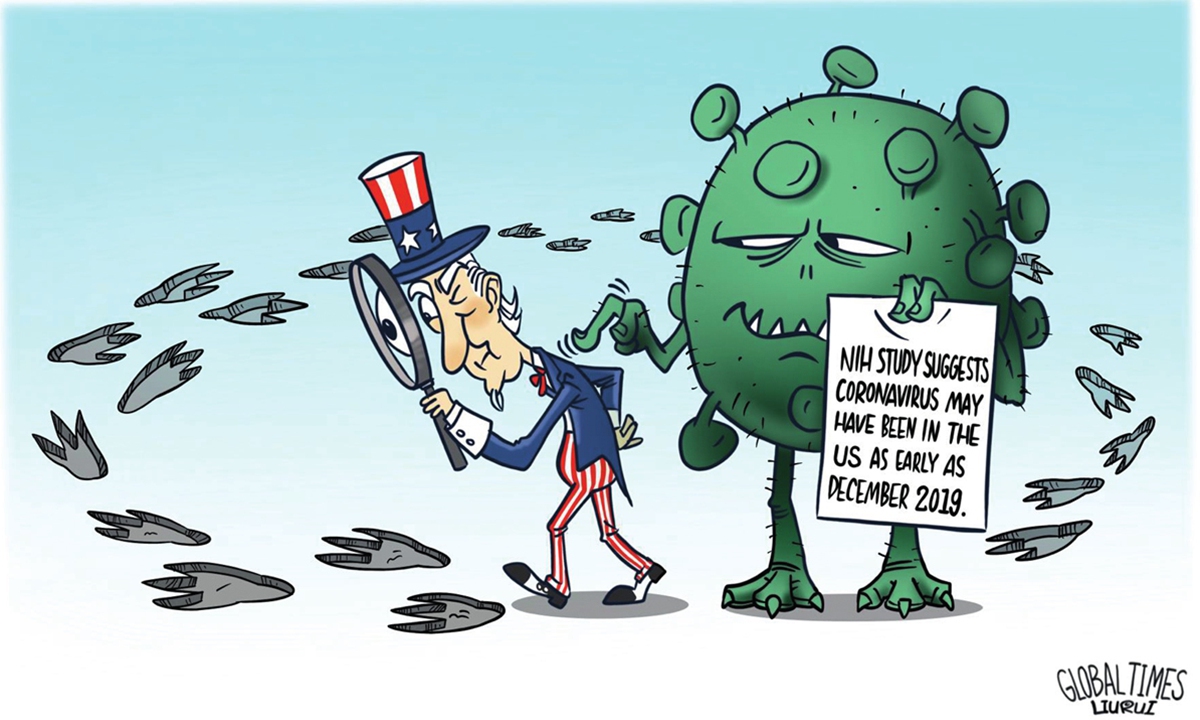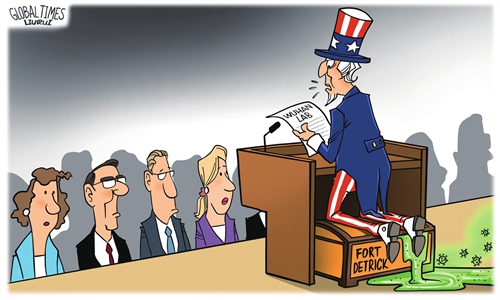US intelligence community’s virus origins report is artificial, political flavoring, not science: Pakistani scholar

Illustration: Liu Rui
Editor's Note:Ninety days have passed since US President Joe Biden ordered for a report probing into the origins of the still ravaging novel coronavirus. On Tuesday, Biden reportedly received a classified report from the US intelligence community that was inconclusive about the origins of the novel coronavirus. It included information about whether or not the virus jumped from an animal to a human, or escaped from a lab in Wuhan. What are the US' intentions behind its origins-tracing maneuver? Global Times (GT) reporter Wang Wenwen talked to Yasir Habib Khan (Khan), founder and president of the Institute of International Relations and Media Research in Pakistan, on these issues.
GT: Do you think it is reliable for the US intelligence agency, which is incapable of judging the situation in Afghanistan, to make the report on the origins of the virus?
Khan: Technically speaking, if we look into professional acumen and integrity, the US intelligence agency stands exposed. Over the last many decades, on home ground to international spheres ranging from Iraq's weapons of mass destruction, Arab Spring, Syrian crisis and recently Afghanistan mayhem, US national intelligence agencies have been losing steam for inept calculations and flawed assessment reports. Given the disrepute, their report on origin-tracing of COVID-19 is another fiasco.
US public's own faith on professionalism of CIA and FBI went into tailspin when a special 11-member investigative body traced abuses of power by the nation's intelligence agencies in 1975.
The worst episodes of unbalanced judgments by the US intelligence agencies came to fore when the US-led invasion destroyed Iraq in 2003 on the wrong plea of weapons of mass destruction. In October of 2002, nine months before the US-led invasion of Iraq, the CIA produced a document summarizing relevant intelligence on Saddam Hussein's chemical and biological weapons programs. On March 31, 2005, the Commission on the Intelligence Capabilities of the United States Regarding Weapons of Mass Destruction reported that the intelligence community was "dead wrong" in its assessments of Iraq's weapons of mass destruction capabilities before the US invasion.
A new book by former CIA deputy director Michael Morell spilled the beans that not only did the intelligence community fail to predict the advent of the series of popular uprisings starting in 2011 known as the "Arab Spring," but also deemed that the movement would "take a heavy toll on Al Qaeda by undermining the group's narrative." The Arab Spring intelligence failure led by the US is an eye-opener when touching upon other issues requiring objective assessments, such as Iran's intentions regarding nuclear weapons, Russia's next moves in Eastern Europe or China's expansion. It encapsulates how policymakers can be in a position to command virtually unlimited information and yet know so very little.
Failure of the US intelligence system has many other glaring examples. One of them is poor assessment on the rise of the Islamic State (IS), an offshoot of Al Qaeda in Iraq, which sprang to life during the US occupation in Iraq. The US garrisoned and occupied for eight years, in which it had assumedly developed countless sources of information and recruited agents of all sorts. And yet, by all accounts, when IS' militants suddenly swept across northern Iraq, the CIA in particular found itself high and dry.
So much so, on the basis of comprehensive information compiled by US intelligence community, the Biden administration had complacent that Afghan forces were capable to defend their territories and even it could take at least three weeks to reach Kabul by Taliban. All assessment proved wrong.
Given the detailed evidences substantiating US intelligence judgments rife with errors and omission, if produced a report on origins tracing will suffer validity and public trust.
GT: Mainstream media in the US have largely reported the report of US intelligence is going to reveal more about the virus' origins. But when a scientist pushed back the idea that the virus was leaked from the Wuhan lab, few US mainstream media reported that. Why is the case? What is the role of the US media in pushing the origins tracing probe?
Khan: It is irony that leaving aside some, US media freedom and integrity are compromised to greater extent. On the issue of virus origin-traceability, US media is polarized. Some feel dictated by authorities at helm of affairs. Some are funded. Many toe the line propagated by the US government in order to show their solidarity with national narrative. Among them there are media outlets that do not practice impartiality and objectivity. Broadly speaking, the reputation of the news media is under siege. According to the General Social Survey, the number of Americans with some or a great deal of trust in the press has dropped 30 percentage points since the late 1970s. Even Trump used to call mainstream media as "fake media."
If looked into behavior of US media to see how it report, it is evident what is being published and aired on origins tracing investigation is not the result of unbiased evidences but ulterior motives.
However I am still optimistic that there might be some US media that will uphold the supremacy of truthfulness. Recently media also published a study on the issue. A new antibody testing study examining samples originally collected through the National Institutes of Health's All of Us Research Program found evidence of SARS-CoV-2 infections in five states earlier than had initially been reported. These findings were published in the journal Clinical Infectious Diseases. The results expand on findings from a Centers for Disease Control and Prevention study that suggested SARS-CoV-2, the virus that causes COVID-19, was present in the US as far back as December 2019. This report is one of evidences to debunk Wuhan lab leak theory.



